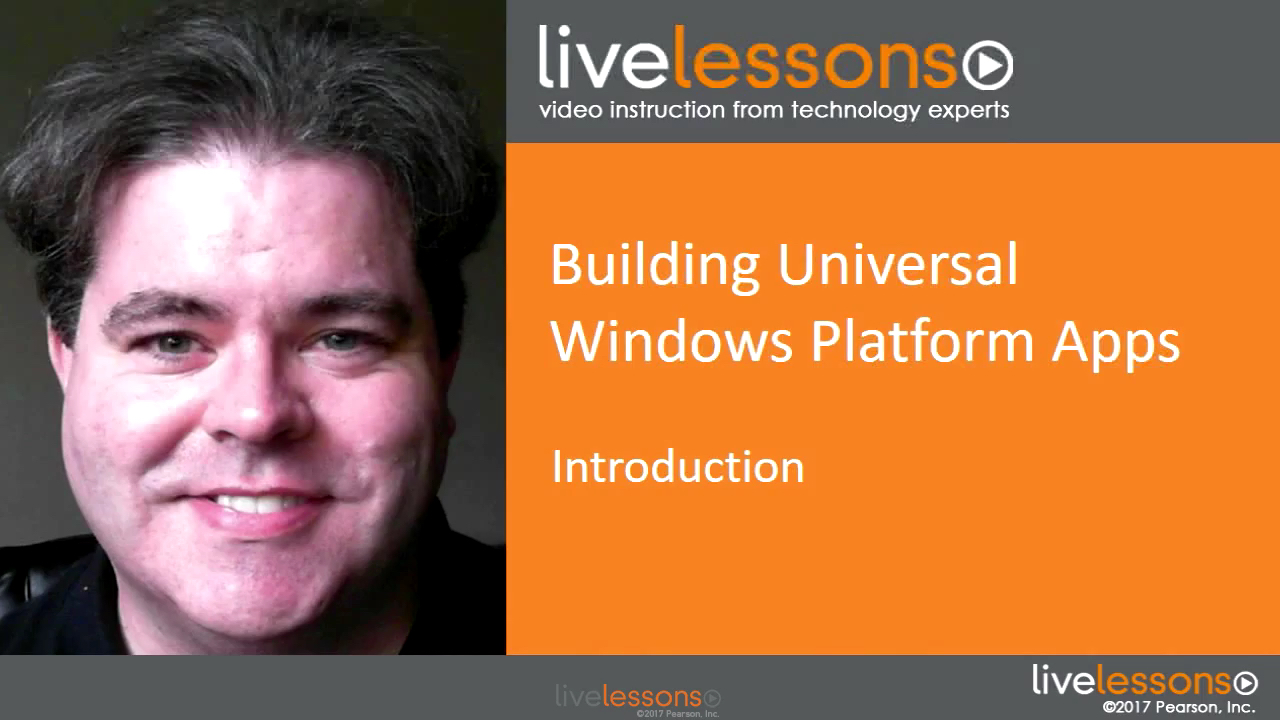Building Universal Windows Platform Apps LiveLessons (Video Training)
- By Colin Melia
- Published Apr 11, 2017 by Sams. Part of the LiveLessons series.
Online Video
- Sorry, this book is no longer in print.
- About this video
Video accessible from your Account page after purchase.
Register your product to gain access to bonus material or receive a coupon.
Description
- Copyright 2017
- Edition: 1st
- Online Video
- ISBN-10: 0-13-466022-6
- ISBN-13: 978-0-13-466022-6
10+ Hours of Video Training
Learn, start-to-finish, how to create your own Universal Windows Platform (UWP) apps for business or consumer use. Build adaptive UI with XAML for a range of devices with different form factors and Windows 10 versions, and learn to use a wide range of evolving UWP capabilities.
Description
Universal Windows Platform (UWP), introduced in Windows 10, is a common app platform used for development, deployment, and running of software on a variety of Windows devices. Building Universal Windows Platform Apps LiveLessons video training shows the foundation of UI building as well as how to adapt the UI on the fly to different device formats. Learn how to use major features of the platform to further engage users, leverage development tools, and get an application ready for deployment.
Throughout the video training, Microsoft Regional Director & MVP Colin Melia builds code that you can then reproduce yourself, including a sample application built up throughout the lessons. The sample code used in this video training is available on GitHub: https://github.com/
Skill Level
- Intermediate
Learning Objectives
- Develop for a huge number of Windows devices
- Learn what's new in Windows 10/UWP
- Build UI with XAML
- Build adaptive UI
Course Requirements
- Some C# experience
- Basic familiarity with the .NET Framework
Who Should Take This Course?
- Microsoft developers for desktop, mobile, Xbox, and other Windows 10 device families
Table of Contents
Introduction
Lesson 1: Platform Introduction
Lesson 2: Building UI
Lesson 3: Data and Asynchronous Tasks
Lesson 4: Navigation
Lesson 5: Application Architecture
Lesson 6: Creating Controls
Lesson 7: Adaptive UI
Lesson 8: Application Lifecycle
Lesson 9: Using Platform Capabilities
Lesson 10: Visual Studio Features
Lesson 11: Preparing for Deployment
Summary
About LiveLessons Video Training
The LiveLessons Video Training series publishes hundreds of hands-on, expert-led video tutorials covering a wide selection of technology topics designed to teach you the skills you need to succeed. This professional and personal technology video series features world-leading author instructors published by your trusted technology brands: Addison-Wesley, Cisco Press, IBM Press, Pearson IT Certification, Prentice Hall, Sams, and Que. Topics include: IT Certification, Programming, Web Development, Mobile Development, Home and Office Technologies, Business and Management, and more. View all LiveLessons on InformIT at: http://www.informit.com/livelessons
Sample Content
Table of Contents
Introduction
Lesson 1: Platform Introduction
Learning objectives
1.1 Understand the course
1.2 Discover the platform
1.3 Discover adaptive code /UI
1.4 Learn platform capabilities
1.5 Get started with Visual Studio
1.6 Understand build & packaging
Lesson 2: Building UI
Learning objectives
2.1 Use XAML
2.2 Display content
2.3 Understand layout
2.4 Understand panel controls
2.5 Use interactive controls
2.6 Apply styling
2.7 Use animation
2.8 Understand advanced controls
2.9 Start the sample app UI
Lesson 3: Data and Asynchronous Tasks
Learning objectives
3.1 Understand file I/O
3.2 Make REST calls
3.3 Use a local database
3.4 Use threading
3.5 Adding data I/O to the sample app
Lesson 4: Navigation
Learning objectives
4.1 Understand frames and navigation
4.2 Enable the back button
4.3 Use dialogs
4.4 Create a multi-window application
4.5 Add navigation to the sample app
Lesson 5: Application Architecture
Learning objectives
5.1 Understand data binding
5.2 Use compiled binding
5.3 Apply the MVVM architecture
5.4 Apply a command infrastructure
5.5 Update the architecture of the sample app
Lesson 6: Creating Controls
Learning objectives
6.1 Create user controls
6.2 Create control templates
6.3 Create templated controls
6.4 Create custom panels
6.5 Create attached properties
6.6 Enhance sample app UI
Lesson 7: Adaptive UI
Learning objectives
7.1 Understand adaptive techniques
7.2 Apply scaling
7.3 Use SplitView
7.4 Use relative panel
7.5 Use Visual State Manager
7.6 Use adaptive triggers
7.7 Understand tailored views
7.8 Update sample app with adaptive UI
Lesson 8: Application Lifecycle
Learning objectives
8.1 Understand the application lifecycle
8.2 Use extended execution
8.3 Use background tasks and triggers
8.4 Create opportunistic tasks
8.5 Update life cycle support in the app
Lesson 9: Using Platform Capabilities
Learning objectives
9.1 Use adaptive tiles
9.2 Use toasts
9.3 Handle file extensions
9.4 Use app launching and protocol handling
9.5 Share data
9.6 Use drag and drop
9.7 Use and create app services
9.8 Use Cortana
9.9 Use in-bound notifications
9.10 Access devices
9.11 Understand platform extensions
9.12 Apply platform capabilities to the sample app
Lesson 10: Visual Studio Features
Learning objectives
10.1 Navigate code
10.2 Debug
10.3 Use performance tools
10.4 Use Blend
Lesson 11: Preparing for Deployment
Learning objectives
11.1 Prepare the app
11.2 Test the app
11.3 Publish the app
Summary
More Information

